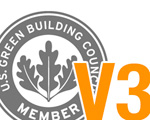It’s official! The all new LEED Version 3 has been launched by the U.S. Green Building Council. The new system makes several big changes that affect everyone from architects and engineers to builders and building owners. This information is especially important if you are working on a LEED project or if you are a LEED Accredited Professional. Here are some of the initial updates at a glance:
LEED Projects
Projects currently registered under LEED V2 can be upgraded to V3 free of charge through the end of 2009, while LEED V2 Online is being phased out. LEED V3 Online will be available to you after you do the free upgrade to V3. The new online features are better, faster, and more streamlined to intuitively meet your needs with the most current information for LEED 2009.
If you plan to build a LEED project, all future registrations are being handled by the Green Building Certification Institute. The GBCI was launched last year to take over the LEED certification process and the LEED professional accreditation process for the USGBC. Over time, the USGBC realized that it just made more sense to split out the people developing the rating system from the people enforcing it.
LEED Accredited Professionals
If you are a LEED AP (Accredited Professional) the GBCI now administers and maintains your credential. If you are pursuing accreditation, there are now 3 levels of expertise you can test for. The basic level, LEED Green Associate, is for non-technical professionals who wish to attain recognition for basic knowledge in green design. This also serves as the first step toward becoming a LEED Accredited Professional (or LEED AP). New this year is the ability for LEED APs to specialize in one of five areas within the program: Building Design + Construction, Interior Design + Construction, Operations + Maintenance, Neighborhood Development, and Homes. Customized tests will be available as early as this summer. The credential of LEED AP has long been the benchmark for demonstrating a thorough knowledge of green design, construction, and operations, but it has now become the intermediate level of accreditation. Finally, the third and highest level of LEED accreditation is to be named a LEED Fellow. This credential is still being developed, but it promises to distinguish professionals for their years of experience in green building and for their contributions toward the further development of the field.
Timeline
- April 27, 2009 – LEED V3 Launches
- June 27, 2009 – All new projects required to register for LEED 2009
- Dec 31, 2009 – Deadline for free upgrade of projects from V2 to LEED 2009 and LEED Online V3
Acoustics
LEED for Schools, LEED for Healthcare, and LEED for Operations and Maintenance already include prerequisite points for acoustical performance. In addition, each of these programs give designers the opportunity to earn innovative design points through achieving outstanding levels of acoustical performance. We’re seeing a big trend of LEED points being added for acoustics, and it is likely to keep being added to more LEED categories in the future.
What this means for the rest of us is that green buildings are here to stay. As an independent acoustical consulting and audio-video design firm, we are discovering new ways to optimize technology for energy efficiency and to design architectural acoustic features that enhance the acoustical environment while saving energy costs. With a LEED Accredited Professional on our staff and many LEED Projects in our portfolio, we are helping to pave the way toward a greener, more sustainable future.
Click here for more on LEED V3.

I love this. finally i got som info..